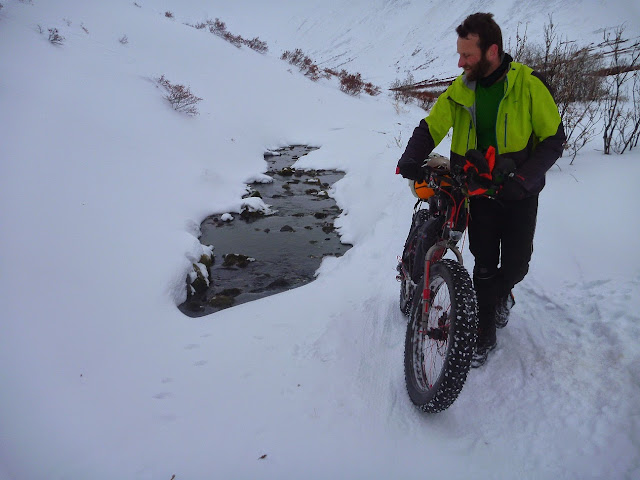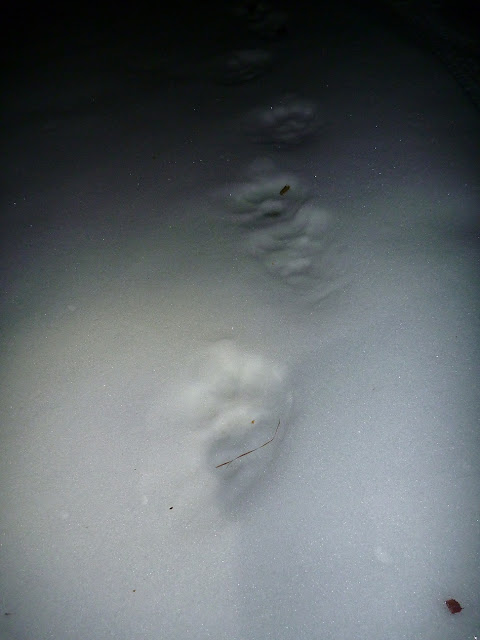I savoured around 4 hours sleep in the cabin, banking the time that I'd
lose unpacking and packing the bivvy and kit. My regular breakfast of oatmeal,
a Bonk Breaker bar, peanut butter cups and a hot cocoa was an efficient affair
today - enjoyed even more by the warm fire. Checkpoint suck. I got moving, into
my gear and just about ready to leave, my friend Jim appeared from the shadows
to get ready as well. We chatted, laughed and joked about the trail. His bike
was playing up - too many falls on the trail left his shifting all out of
alignment - 'no wuckers mate, I'll get
her sorted' was my response in true aussie drawl, naturally this was a foreign
language to him and I'd have to repeat myself - but this was part of our comedy
routine.
Word got around quick - I had
several racers bikes lined up with the same malady. Thomas wasn't able to ride
many segments, reduced to pushing the bike a lot of the distance - this
explained his general malaise when I last saw him a day ago at Shell Lake Lodge.
Re-align the derailleur hangers, reset limit screws, adjust cable tension and
gear operation restored. Thomas was off like a gunshot, a quick test of the
gears, he was off down the trail and I never saw him again during the race - it
felt good to have had a positive influence on another racers' outcome.
Jim wanted to shout me a big
breakfast as thanks for the repair. The rookie racer in me was eager to get going,
I'd given away a bit of time already, however the next segment over Rainy Pass
was best tackled with another racer if possible. I was also learning how the
camaraderie on the trail was important to the experience of Iditarod - there is
no prize money in this race, no podium. The only things you get are the gold
medal friendships that are forged through shared hardship, the battle scars you
earn through suffering and the memories that never fade. Helping myself to
triple helpings of bacon and eggs, pancakes drizzled with maple syrup, taking
in the atmosphere of the lodge and the incredible views over the lake - well
that's an experience you can't forget or say no to.
Our trio left the lodge around 9am. Jim was a veteran of Iditarod, it was
great to be learning some of the tricks and route nuances from a man of his
calibre. I joked with him that there was a mythical Churro stand at the top of
the pass, run by latinos and we better get there quick as they don't like being
out in the cold for long.
Down on the valley floor, the scrub Willow is both a blessing and a curse.
The short, stubby branches grab at your spokes, chain and rear derailleur -
you've really gotta watch your line so the derailleur and hanger don't become a
statistic. But in contrast, the Willow also shows you the shortest way through
the valley, as you can see the bark has been scuffed from the snowmachines when
Bill and his team cut the trail a few weeks prior. This is an instance where navigation by GPS
does not work effectively - it might show you the general direction to head,
but it won't reveal the exact line to follow - you have to rely on ground
intel. There are also deep, hidden streams waiting to swallow you if you veer
off the safety of the trail.
We all fell off a few times - the central trail gets compacted by
snowmachine and racers, so it forms this centre ridge about a foot or two wide.
Off to the side of this ridge, the snow can be many feet deep. In low
contrast/visibility conditions though, it can be hard to stay on the ridge.
When you veer off trail and fall, you fall into this bottomless powder, along
with your bike on top of you. You virtually have to swim out of the snow to get
back onto the trail and then fish your bike out.
Sometimes there is trail, sometimes not. Sometimes it's just a thin crust
over a stream, and your boot punches through. There were a few racers' 'fall'
imprints, some into the sub-ice crust streams.
Up on the plateau there is a huge frozen lake and a small hunters cabin,
there is no trail and you just make your way forward as best you can - it's not
like you can take a wrong turn. I thoroughly scanned the area for the Churro
stand.
We reached the summit of the pass and high fives all around. Obligatory pic at the sign, it was getting
late and we needed to move forward - a light snow was falling and visibility
was starting to drop. The descent was punchy with a lot of traps.
Lars fell into a deep snow hole,
hyperextended his knee as he was extricating himself. It was almost a game
changer for him - the leg could not bear weight and we were descending into one
of the most remote areas of the 350 race - into the Dalzell Gorge and to Rohn
checkpoint. I could not leave him, I later found out that he'd left his
sleeping pad at Rainy Pass, so there was no chance of a bivvy for him. We
worked through a strategy, had a snack and some anti-imflammatories, he rode
slowly ahead to set the pace, I had time to meander and fuss with my camera.
I fell many times on the glare ice shelves further down the gorge - this is
where my knees really copped some abuse, falling directly into a kneeling
position many times as I prevented the bike falling into the abyss. I really
should have put my crampons on. Lars had moved well forward, I slowed down to
take it all in and calculate my moves (Lars had a GPS trail, whereas I was
still following ground intel, trail cues and markers) and it's when you slow
down, you start to notice more things - like the Wolverine prints in the snow.
The trail led onto the confluence of the Tatina River and the Kuskokwim River. I was still a way off from Rohn
checkpoint and the river section in front of me was what nightmares are made
of. Let me paint a picture: there was virtually no snow, so the light from my
headlamp was absorbed by the dark shapes and surfaces. The ice was black, hard
and slick - even the hardened steel runners from the hunters snowmachines
barely left a mark on the ice - which meant the safe path on the ice vanished. I had to use my backup light - an Exposure
Joystick - to highlight the details in the ice, but it still didn't extend very
far. Off to the side I could hear the river rushing under the ice through
holes. The ice would creak, crack and groan as I rode over it, impossible to
gauge how thick or stable it was, whether it was rotten, corniced or hollow underneath. Even the camera was puckering - it didn't want to focus...



















Thanks again for your help, Troy. Reading your blog is like living through this adventure again. I am sure you will make it to Nome and will follow and cheer you from afar!
ReplyDeleteThomas
Good luck Troy - hard yards are always worth it. Very selfless helping the injured rider, some people need reminding it's not about winning all the time this kind of spirit is good to see. ref: knees- You clearly needed your Bliss pads!
ReplyDelete